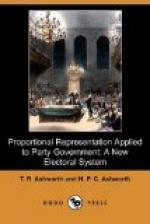At a meeting held at River House, Chelsea, London, in 1894, Miss Spence submitted an analysis of 8,824 votes recorded at 50 public meetings in South Australia. The audiences were in each case asked to select six representatives out of twelve candidates. The result of a scrutiny of all the votes combined was that the following six “parties” secured one “representative” each—viz., Capital, Labour, Single Tax, Irish Catholic, Prohibition, and Women’s Suffrage. Miss Spence frankly confesses that these “parties” are minorities, but holds that a majority can be formed by the union of minorities, and that party responsible government can still be carried on. Now, can any sensible man or woman imagine a working ministry formed by a union of any four of these “parties?” Capital would certainly be permanently opposed to Labour and to Single Tax, and as for the others, there is not a single principle in common. How, then, could a union be formed? The only possible way is by log-rolling; they must make a bargain to support one another’s demands. Such a union could not possibly be stable, because the minority is free to offer a better bargain to any one of the “parties” to induce it to desert. Again, it may be called the rule of the majority, but what sort of a majority? Is it not plainly the rule of a majority in the interests of minorities? That is very different to the rule of the majority in the interests of all, which free government demands. The simple truth is that the “parties” are factions, and that the “representatives” are mere delegates of those factions.
But in practice the case would be far worse than we have assumed. There is not the slightest guarantee that the same six factions would be elected in each six-seat electorate. We might have an unlimited number of delegates of various religions, classes, races, localities, and political organizations on all kinds of single questions. An assembly formed on these lines could hardly be dignified with the name of a representative assembly.
Mr. G. Bradford, in his work on “The Lesson of Popular Government,” displays a more intimate knowledge of human nature than any other recent writer. Of these schemes for the representation of minorities he says:—
As an illustration of the effect in popular government of looking to popular impulse for the initiation of measures, it may be observed that perhaps the worst of all expedients for remedying the defective working of a government by a legislature like ours, that which combines the evils of them all, is one which is urged by perfectly disinterested advocates of reform, and is known as proportional representation. If there is one principle at the base of popular government it is that the majority shall rule. If the largest of three or four fractions is to rule it ceases to be popular government, and becomes government by faction. If the tyranny of the majority is bad a tyranny of the minority is still worse. (Vol. i., p. 505.)
And the following picture could hardly be better drawn:—




